
Introduction
Marketing is an art as much as it is a science – it takes creativity to sell and it takes math to ensure you remain profitable. It’s the difference between coming up with ”Just Do It” and using that brand recognition to generate sales.
Thanks to the advancement of AdTech, marketers have more ways than ever to get their message across – from Netflix to screens at the gas station. But before you sink your marketing budget into the Next Big Thing, you need to understand how to track and measure the performance of your campaigns. In fact, only 39% of companies are able to attribute all their marketing campaigns, meaning 61% of companies are alarmingly playing the guessing game.
Throughout this guide, you’ll learn everything you need to know about marketing attribution, why it’s important, the different methodologies, and how to measure your ads effectively.

Chapter 1
What is marketing attribution?
Marketing attribution is the ability to determine which marketing channels and campaigns are driving leads, sales, and conversions, giving you an accurate picture of your ROI. This means you’re able to measure the true impact of all your marketing activity, from out-of-home advertising to your Google Ads campaigns.
Marketing attribution vs marketing measurement: what’s the difference?
While they’re both essential in evaluating the effectiveness of marketing campaigns, attribution and measurement describe different things.
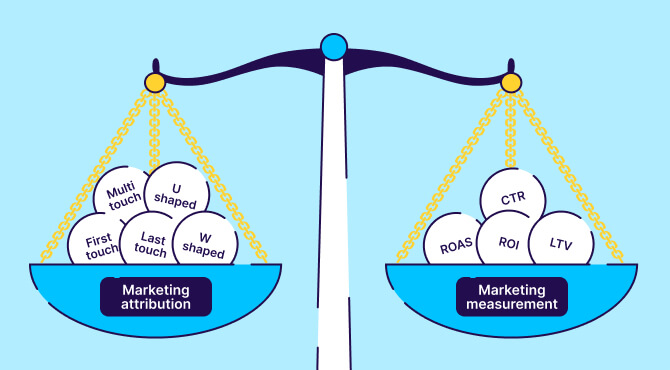
Marketing attribution identifies how much each touchpoint and channel within a customer journey contributes to the conversion. Attribution can assign a weight to each touchpoint, which helps marketers identify which channels are the most effective.
Marketing measurement assesses the effectiveness of marketing campaigns by quantifying their impact with numbers like impressions, click-through rates (CTR), conversions, return on investment (ROI), and return on ad spend (ROAS).
In short, marketing attribution determines how each touchpoint contributes to the customer journey, while marketing measurement quantifies the performance of marketing campaigns with metrics.
More specifically for mobile marketers, it’s essential to understand which marketing activities and touchpoints are driving app installs by measuring user engagement across multiple devices and platforms.
Why is marketing attribution important?
If attribution isn’t part of your marketing toolkit, you’re missing out on vital information — and you could be wasting your budget. Here’s why it matters:
- Marketing attribution helps paint a whole picture of how every marketing campaign contributes to the customer journey – from the first time they hear about your brand all the way to buying your product or service. That journey in between the first and last touch is often referred to as “the messy middle,” where many marketers struggle to effectively measure how impactful their campaigns are from start to finish.
- Marketing attribution provides a clear understanding of where your ad dollars are going. While it may be tempting to throw all your money at a SuperBowl ad, the likelihood that someone will purchase your product on the spot is close to zero. With proper attribution, you can identify what campaigns you need to run building up to it and after, so you can generate sales over time through various touchpoints. For example, attribution can show you that the SuperBowl ad was successful at introducing your brand to a large audience, but your Instagram ad might be what drives the most conversions.
- Marketing attribution helps with budget allocation when configuring your marketing mix. As mentioned above, attribution gives weight to certain campaigns or channels, depending on their effectiveness throughout the buyer’s journey. If more customers are converting via Instagram ads, it doesn’t mean you should shut down every other campaign. Proper attribution shows you how each touchpoint leading up to the Instagram ad contributes to driving that sale. Alternatively, you might see that your expensive ads on Google aren’t contributing to the journey, so you can re-allocate those resources elsewhere.

Chapter 2
Marketing attribution benefits vs. challenges
Like most things in marketing, there’s no one-size-fits-all approach to marketing attribution. While this approach has many benefits, there are also some drawbacks to consider.
Benefits
Let’s start by diving into the various ways marketing attribution can be beneficial to your marketing function.
1. Budget allocation
As mentioned above, marketing attribution is the key to measuring the contribution of your marketing campaigns throughout a customer’s buying journey. It enables you to allocate your resources to not only the channels and campaigns that drive the eventual conversion, but also those that contribute to making the purchase decision elsewhere in the funnel. With this bird’s-eye view, you can allocate budget more strategically, rather than aggressively thinking about the short term.
2. Alignment between marketing and sales
Marketing and sales teams are increasingly overlapping – to the point where the two are sometimes known as smarketing. Because attribution is able to provide a balanced and data-driven approach to the entire buying process, marketing and sales teams have a clearer understanding of their contributions to revenue.

3. Highlighting growth opportunities
Attribution not only highlights which elements of a campaign are most (or least) effective, but also provides insights into user segments based on their interaction history and behaviors. Data from attribution can reveal how certain segments interact with a mobile app after being exposed to a particular ad campaign, or how that campaign affects user retention.
Challenges
Let’s now examine some of the difficulties and drawbacks of marketing attribution.
1. Privacy changes are making attribution more difficult
Visions of a cookie-less future, increased use of ad blockers, and Apple’s App Tracking Transparency (ATT) privacy policy all pose challenges for campaign measurement. As advertising rules become increasingly convoluted and restrictive, marketers must find creative ways to navigate them, including working with a mobile measurement partner (MMP).
2. Some channels are difficult to track accurately
While digital campaigns are much easier to track, data can be fragmented when trying to bake in the impact of campaigns like out–of-home billboards. Cross-device behavior can pose a challenge for longer and more complicated customer journeys. And with so many platforms to measure your campaigns, there’s no uniform naming or data structure, which may complicate aggregation and reporting.

3. There’s no one-size-fits-all approach
There’s no one approach to attribution that works for everyone. We’ll cover the different types of attribution models later, but each approach comes with its own benefits and drawbacks as well. For example, while single-touch models are undoubtedly more straightforward, they may overvalue the impact of first and last touchpoints.
Common mistakes with attribution
Marketing attribution requires meticulous planning and a strong strategic direction. Here are some of the most common mistakes to avoid.
1. Measuring marketing success based only on the first or last click
Platforms like Google Ads often measure success based on which ad creative drives the most conversions, which leads marketers to look at their ad campaigns in a very linear way. But attribution is about understanding the holistic picture, and provides a measured response to how each impression contributes to that eventual conversion. While it may be tempting to double down on ad creatives that convert the best, it’s equally important to understand the impact of the ads that lead up to that point.
2. Nowhere to store the data
Collecting data, aggregating reports, and effectively measuring your campaigns is difficult when dealing with a wide range of marketing channels. Marketers need a safe and secure place to store all that data, but also a structure to effectively organize large attribution data sets.
3. Short or long measurement windows
Buying cycles differ depending on the customer segment, your product offering, pricing, and timing. That’s why it’s important to set a time frame that makes sense when measuring attribution. A window that’s too short may not paint the whole picture, while a too-long window can give too much credit to ineffectual campaigns.

Chapter 3
Marketing attribution models
Imagine you see an ad on TV, engage with a funny Instagram post from the same brand, then buy the product at a physical store. Which channel would you credit the sale to? It’s not an easy question, which is why there are several marketing attribution models to consider.
What marketing attribution models exist in the mobile ecosystem?
Now that we’ve covered the basics of attribution, let’s talk about the different approaches. There are two schools of thought: single-touch attribution and multi-touch attribution.
Single-touch attribution
Single-touch attribution assigns full credit to one touchpoint, whether it be the first interaction, last interaction, or where the lead is created.
First-touch attribution model
This model assumes the customer purchases after the first advertisement they’ve seen. Full credit is given to the first touchpoint, regardless of ads encountered afterwards.

Example:
I see a YouTube pre-roll ad for a mobile game. I then see an Instagram ad a few times. I eventually click on a Facebook ad to download the game. First-touch attribution would give full credit to the YouTube pre-roll ad.
Last-touch attribution model
Full credit is given to the last ad that a customer interacts with before making a purchase. This model gives no credit to any of the previous ads.

Example:
I see a YouTube ad for a mobile game. Then I see a series of ads on blogs. I download the game from a link in a promotional email. With last-touch attribution, the email is given 100% of the credit.
Lead conversion touch attribution model
Full credit is given to the touchpoint that collects a lead, such as entering an email address to sign up for a newsletter.
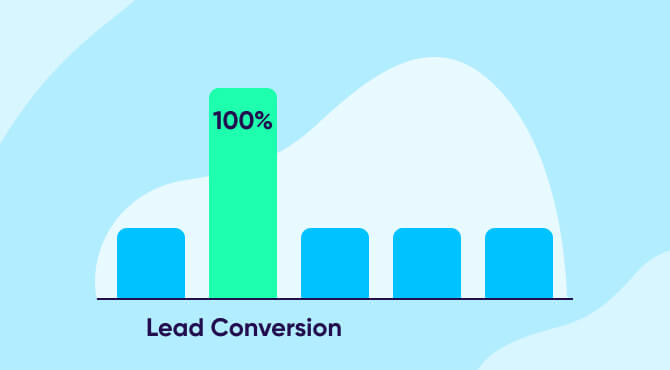
Example:
I see a series of Instagram ads for a new mobile game. However, I enter my information for a promotional giveaway on the game’s website. With the lead conversion touch attribution model, the website is given 100% of the credit.
Last non-direct attribution model
This model gives full credit to the last channel that the customer clicked before converting and removes all credit from direct traffic. This assumes that anyone who directly types in your website URL or AppStore page is already converted and far enough along the purchase cycle.
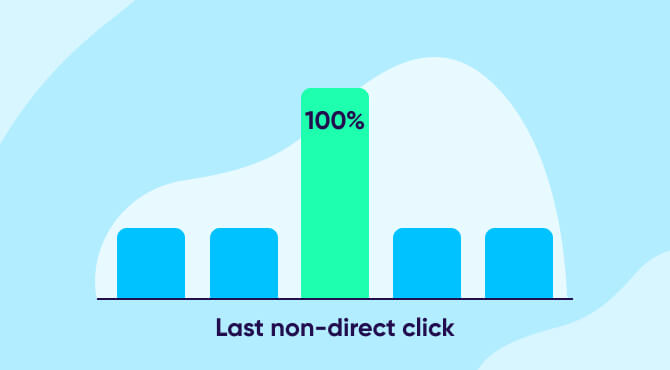
Example:
I see an ad while watching a show on Hulu. Then I type in the website URL on my phone and make a purchase. The last non-direct attribution model would give full credit to the Hulu ad.
Multi-touch attribution
Multi-touch attribution assigns different weights and values to multiple touchpoints that a customer engages with during their purchasing journey. In contrast to single-touch attribution, this approach paints a fuller picture of the contribution of all your marketing campaigns, but is also a lot more complicated to measure. Here are the most common types of multi-touch attribution.
Linear attribution model
In this model, every touchpoint a customer encounters is given equal credit. This assumes every ad has the same impact in persuading the customer to convert.
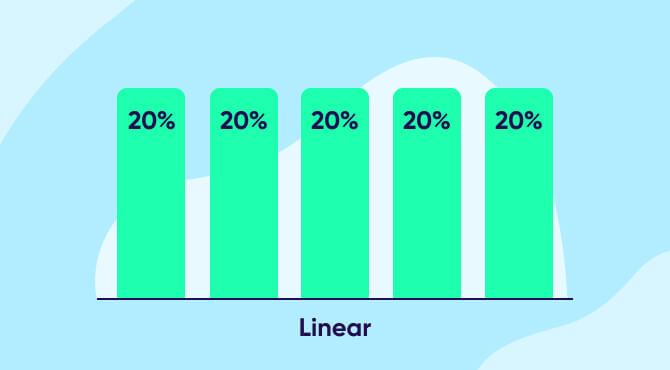
Example:
I see a fitness app while watching a preview at the movie theater. Then I see ads for this app on YouTube, on a mobile game, and in the newspaper. I eventually download the app from an Instagram ad. Linear attribution would give equal credit to each of these touchpoints.
Time-decay attribution model
This model gives more weight to touchpoints closer to the conversion, which assumes older interactions are less impactful than more recent ones.
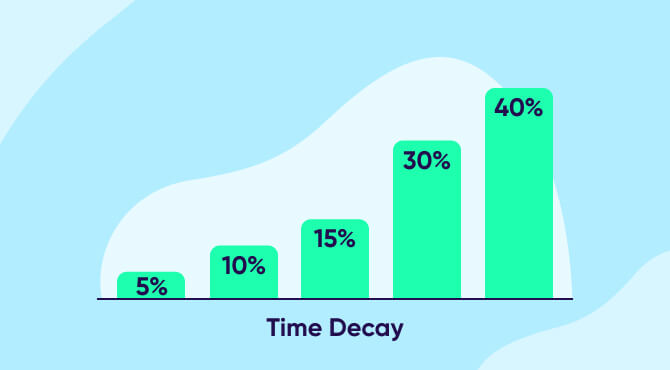
Example:
I see a series of 10 YouTube ads for a new mobile game. I download the game after watching the 10th ad. The most weight would be given to the ads closest to the conversion, while the first few ads would be given little to no weight.
U-shaped attribution model (position-based attribution model)
In this model, first and last touchpoints are given the most credit, while interactions in between are given a little credit as well. This is a more balanced approach to first-touch or last-touch attribution.
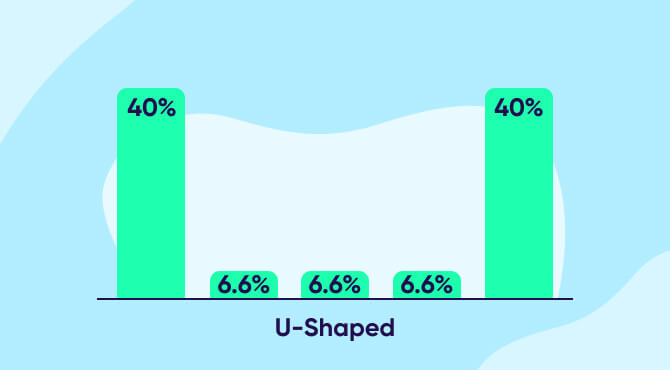
Example:
I first notice a brand on a Facebook ad, and eventually convert through a YouTube ad. In between, I’ve seen multiple ads on my streaming services, mobile games, and browsing the web. The Facebook ad and YouTube ad would be given the most credit, while the touchpoints in between are equally weighted.
W-shaped attribution model
Similar to U-shaped attribution, W-shaped attribution gives most credit to the first and last touchpoints, plus a third one – the opportunity creation. All other remaining touchpoints are split equally.
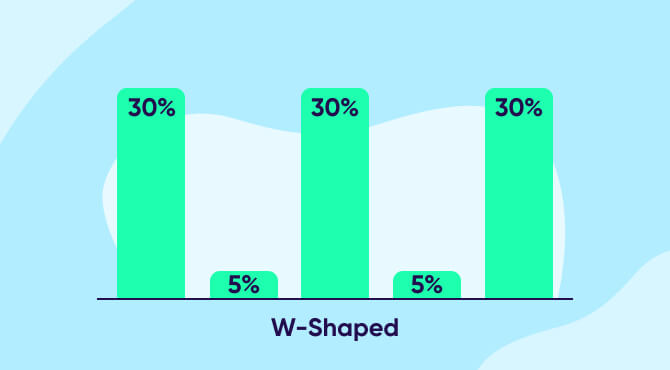
Full-path attribution model (Z-shaped attribution)
This model gives different weights to different touchpoints across the entire customer journey, depending on the effectiveness of each individual interaction. While this provides a more holistic view, it’s also the most difficult to execute.

Custom attribution model (mix and match)
This approach involves a combination of multi-touch models depending on business needs or individual campaign goals. For example, you might use a W-shaped attribution approach to your new mobile game, while using a time-decay model for an app that goes viral.


Chapter 4
Marketing attribution strategy: Best practices and implementation
Now that you know all the types of attribution models, let’s discuss how to use them efficiently.
How to choose the right attribution model for you
With so many models to choose from, how do you pick the best one for you? A good place to start is by auditing your marketing campaigns. Here are a few things to consider that will help you better determine which models make the most sense.
- Identify your conversion paths
How complicated is your purchasing journey? Is it a fairly straightforward decision? Or do users need to be engaged across multiple touchpoints before making the final decision? Investing in a complicated attribution process wouldn’t be worthwhile for short purchase journeys, but could be justified for apps with longer consideration cycles.
- Channel mix
What campaigns are you currently running? Some attribution models work more effectively on certain channels than others. For example, out-of-home billboard ads are much more difficult to measure than Facebook Ads.
- Available tools
Executing an effective marketing attribution strategy depends on the tools available to you. Some marketing channels provide comprehensive measurement tools, while others are more limited. Depending on your budget and current tech stack, you can determine what’s possible and what’s not.
- Data quality
On top of your tool stack, it’s imperative that you can trust the data available to you. A sophisticated attribution model requires secure data storage and potentially working with a mobile measurement partner to ensure accuracy across multiple touchpoints.
What factors should you consider when choosing an attattribution provider?
An attribution partner, also known as a mobile measurement partner (MMP), can help you accurately attribute your marketing campaigns across multiple platforms. With so many providers to choose from, here are a few factors you should consider before choosing the right MMP for you:
- Platform compatibility
The first and easiest way to narrow down your choices is to see if the MMP supports the tracking and measurement of every platform, channel, ad network, tool, and device you’re planning to use.
- Attribution methodology and reporting
Take a look into how the MMP guarantees accuracy in their reporting. How do they provide insights into user-level data? Do they have flexible attribution windows? How are they navigating the ongoing privacy changes? Also check how they’ll report your results – will you get a user-friendly dashboard for easy viewing and analysis?
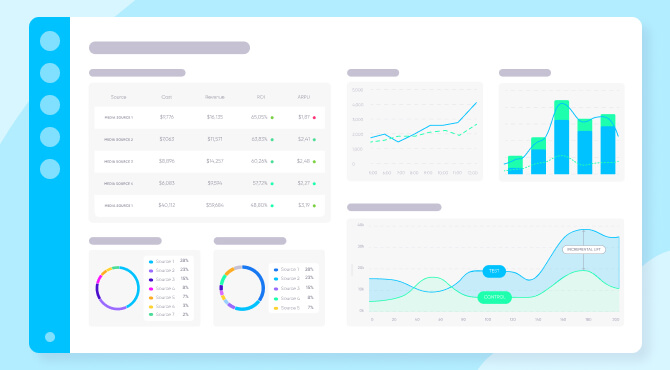
3. Scalability
When running large campaigns across multiple channels at once, you’re working with enormous amounts of data. Identify an MMP that will scale with you – one that will maintain the level of accuracy and privacy as you grow. Look for an MMP that uses data clean rooms, or a vetted pool of first-party data from multiple data sources, which can verify your data without exposing personally identifiable information (PII).
4. Customer support and reliability
Does the MMP have a dedicated customer success team that provides 24/7 support? Do they have credible testimonials and positive customer feedback? Do they support international businesses across time zones and cultures? Do they have reliable uptime? It’s essential to ask these questions when considering an MMP to ensure they can back up their claims of good customer service.
How to implement your attribution model
Now you might be wondering how you actually implement the right attribution model for you. Here’s a good place to start.
- Set clear goals
Start by determining your winning KPIs. If user acquisition is your top priority, you might be measuring conversion rates instead of lifetime value. Creating a list of your top KPIs will set you in the right direction.

2. Choose the right attribution model
Whether it’s last click, first touch, time decay, or full path, determine which attribution model makes the most sense for you.
3. Set up your tool stack
Determine which analytics tools, MMPs, and tracking you’ll have to implement to collect and measure your campaigns.
4. Practice good data hygiene
Audit your data to ensure you have a reliable dataset to work with. Poor data hygiene can lead to catastrophic assumptions and wasted budgets. Ensure you regularly validate your data and check your analytics platforms are working correctly.

Chapter 5
The future of marketing attribution
With more and more channels at our disposal, and marketing budgets increasingly under pressure, the need for high-quality attribution can only grow. But what does the future hold? Let’s look at some key trends.
A privacy-centric world
It’s no secret that Apple’s ATT policies and Google’s shift towards cookieless browsers are transforming how marketers are approaching attribution. What worked yesterday may not work tomorrow.
With increasingly limited access to user identifiers, and opt-in requirements, cross-device tracking makes user matching difficult. This will cause a shift to contextual and first-party data, making apps and organizations with large user bases (and more first-party data) more enticing to acquire. As a result, approaches to marketing attribution will always have to adapt to these market forces.
Artificial intelligence
One of the strongest solutions to these market changes is artificial intelligence (AI). Google Ads, like many other ad platforms, has implemented probabilistic modeling to address increasing privacy regulations and concerns. Advanced machine learning algorithms are helping advertisers not only clean up data sets, but also identify behavioral patterns more effectively with less data.
This allows marketers to be dynamic when measuring the effectiveness of their marketing campaigns, rather than sticking to one, single-touch approach. Machine learning also helps marketers identify effective touchpoints much faster than before, saving time and money in the long run.
Smarter out-of-home solutions
As much as software is improving, so is hardware. While simple solutions like QR codes or unique coupon codes are great ways for brands to measure their out-of-home campaigns, digital out-of-home technology is advancing faster than ever. Some digital products can measure foot traffic and impressions, which is particularly powerful when paired with advanced targeting capabilities integrated with first-party data.

Use of MMPs to mitigate risk
Privacy regulations, changing app store policies, and the ever-evolving landscape of mobile marketing mean tracking data accurately can get complicated. Mobile marketers can find solace in working with an MMP to help future-proof their data and mitigate data loss. MMPs can provide a well-diversified data set so you’re not relying purely on your own data, but industry-level data as well. MMPs also have privacy and security protocols to ensure your data aligns with your business goals while protecting customer privacy.
Key Takeaways
- Marketing attribution is the ability to determine which marketing channels and campaigns are driving leads, sales, and conversions, giving you an accurate picture of your ROI.
- From the first time a customer hears about a brand to the point that they buy a product or service, marketing attribution paints a holistic picture of how each campaign contributes to the customer journey. This helps you allocate budget strategically and identify growth opportunities.
- Marketing attribution can be single-touch (crediting one touchpoint with the conversion) or multi-touch (spreading the credit across various touchpoints in the customer journey). Popular multi-touch models include linear, time-decay, U-based, W-shaped, and custom attribution.
- There’s no one-size-fits-all solution to attribution, so it’s important to determine what your goals are and how complex your purchase cycle is. You also need to identify your tech stack and ensure high data quality.
- Privacy changes and the rise of walled gardens from ad platforms will continue to challenge marketers, but artificial intelligence and MMPs can offer creative solutions to market forces. If you choose to work with an MMP, ensure they can support your platforms and offer accuracy, scalability, and great customer care.




